Spatial Domain Adaptive Control of Nonlinear Rotary Systems Subject to Spatially Periodic Disturbances
Abstract
We propose a generic spatial domain control scheme for a class of nonlinear rotary systems of variable speeds and subject to spatially periodic disturbances. The nonlinear model of the rotary system in time domain is transformed into one in spatial domain employing a coordinate transformation with respect to angular displacement. Under the circumstances that measurement of the system states is not available, a nonlinear state observer is established for providing the estimated states. A two-degree-of-freedom spatial domain control configuration is then proposed to stabilize the system and improve the tracking performance. The first control module applies adaptive backstepping with projected parametric update and concentrates on robust stabilization of the closed-loop system. The second control module introduces an internal model of the periodic disturbances cascaded with a loop-shaping filter, which not only further reduces the tracking error but also improves parametric adaptation. The overall spatial domain output feedback adaptive control system is robust to model uncertainties and state estimated error and capable of rejecting spatially periodic disturbances under varying system speeds. Stability proof of the overall system is given. A design example with simulation demonstrates the applicability of the proposed design.
1. Introduction
Rotary systems play important roles in various industry applications, for example, packaging, printing, assembly, fabrication, semiconductor, robotics, and so forth. Design of control algorithm for a motion system often comes up with nonlinearities and uncertainties. Nonlinearities are either inherent to the system or due to the dynamics of actuators and sensors. Uncertainties are mainly caused by unmodeled dynamics, parametric uncertainty, and disturbances. For dealing with nonlinearities, common techniques, for example, feedback linearization and backstepping, are to utilize feedback to cancel all or part of the nonlinear terms. On the other hand, design techniques for conducting disturbance rejection or attenuation in control systems mostly originate from the internal model principle [1], for example, those incorporating or estimating the exosystem of the disturbances [2–6]. Conventional controllers are mostly time-based controllers as they are synthesized and operate in temporal or time domain. Several researches [7–9] have started studying spatial domain controllers ever since a repetitive controller design was initiated by Nakano et al. [10]. In the design of Nakano et al., the repetitive control system has its repetitive kernel (i.e., e−Ls with positive feedback) synthesized and operated with respect to a spatial coordinate, for example, angular position or displacement. Hence its capability for rejecting or tracking spatially periodic disturbances or references will not degrade when the controlled system operates at varying speed. All existing studies propose design methods starting with a linear time-invariant (LTI) system. After reformulation, a nonlinear open-loop system is obtained in spatial domain. Subsequently, the open-loop system is either linearized around an operating speed or regarded as a quasi-linear parameter varying (quasi-LPV) system and then adjoined with the spatial domain internal model of the tracking or disturbance signal. Design paradigms based on linear (robust) control theory are then applied to the resulting augmented system. However, presuming the open-loop system to be LTI and resorting to design paradigm of linear control will inevitably restrict the applicability and limit the achievable performance of a design method. Chen and Yang [11] introduced a new spatial domain control scheme based on a second-order LTI system with availability of state measurements. To achieve robust stabilization and high-performance tracking, a two-module control configuration is constructed. One of the modules utilizes adaptive backstepping with projected parametric adaptation to robustly stabilize the system. The other module incorporates a spatial domain internal model of the disturbances cascaded with a loop-shaping filter to improve the tracking performance.
This paper extends the work of Chen and Yang [11, 12]. The control scheme has been generalized such that it is applicable to a class of nonlinear systems (instead of just LTI systems). Moreover, the major shortcoming in Chen and Yang’s design [11], that is, which requires full-state feedback, is resolved by incorporation of a nonlinear state observer. Various types of nonlinear state observers have been developed and put into use in the past (e.g., [13, 14]). This paper will study the feasibility of incorporating a K-filter-type state observer [13] into the proposed design. The proposed system incorporating the state observer can be proved to be stable under bounded disturbance and system uncertainties. An illustrative example is given for demonstration and derivation of the control algorithm. Simulation is performed to verify the feasibility and effectiveness of the proposed scheme. Compared to the preliminary work in [12] (which is only applicable to second order systems), the results have been generalized to be suited for nth order systems. Specifically, the design and stability proof are more comprehensive and rigorous than those presented in [12].
Recently, there have been emerging design techniques based on adaptive fuzzy control (AFC), which may cope with nonlinearities and uncertainties with unknown structures [15–17]. The major differences between those techniques and the proposed one are as follows: (1) design being time based (AFC) versus spatial based (the proposed approach); (2) assuming less information about the nonlinearities/uncertainties (AFC) versus more information about the nonlinearities/uncertainties (the proposed approach). Note that the spatial-based design is not just a change of the independent variable from time to angular displacement. A nonlinear coordinate transformation is actually involved. Therefore, the systems under consideration in AFC and the proposed method are different. Next, the capability of the design approaches suggested in AFC for tackling systems subject to a more generic class of nonlinearities/uncertainties lies in the usage of a fuzzy system to approximate those nonlinearities/uncertainties. It is actually not clear regarding the complexity of the fuzzy system (i.e., number of membership functions) that should be used to achieve the required control performance. It is also not clear whether or not the control effort is reasonable. In general, when characteristics of the uncertainties or disturbances are known, such information should be incorporated as much as possible into the design to enhance performance, avoid conservativeness, and result in sensible control input. Hence, instead of assuming the disturbances to be generic (probably just being bounded as by AFC), the proposed design is aiming at a type of disturbances specific to rotary systems and utilizes the spatially periodic nature of the disturbances to establish a well-defined control module integrated into the overall control configuration.
This paper is organized as follows. Reformulation of a generic nonlinear rotary system with respect to angular displacement will be presented in Section 2. Design of the state observer is described in Section 3. Section 4 will cover derivation and stability analysis of the proposed spatial domain output feedback control scheme. Simulation verification for the proposed scheme will be presented in Section 5. Conclusion is given in Section 6.
2. Problem Formulation
3. Nonlinear State Observer
- (1)
and are linearly related to those unknown system parameters, that is,
() - (2)
Equation (3.1) is minimum phase, and the internal dynamics in (3.6) is ISS (input-to-state stable).
- (3)
The output disturbance is sufficiently smooth, that is, exist.
- (4)
exist, that is, the transformed unstructured uncertainty is sufficiently smooth.
- (5)
The reference command and its first r derivates are known and bounded. Moreover, the signal is piecewise continuous.
4. Spatial Domain Output Feedback Adaptive Control System
Step 1 (i = 1). With (4.4), the first state equation of (4.3) can be expressed as
Step 2 (i = 2, …, r − 1). With respect to the new set of coordinates (4.4), the second equation of (4.3) can be rewritten as
Step 3. With respect to the new set of coordinates (4.4), the third equation of (4.3) can be written as
Substituting (4.16) into , we have
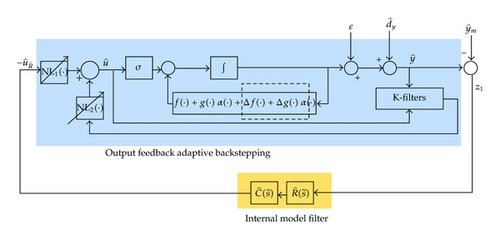
Theorem 4.1. Consider the control law of (4.16) and (4.23) applied to a nonlinear system with unmodeled dynamics, parameter uncertainty and subject to output disturbance as given by (3.1). Assume that (where r is the relative degree) and are known and bounded, are sufficiently smooth, are Lipschitz continuous functions, at least one column of is bounded away from zero. Furthermore, suppose that a loop-shaping filter is designed such that the feedback system is stable. Then the modified parameter update law as given by (4.19) yields the bounded tracking error.
Proof. Step 1 (show that only needs to be considered).
Denote by the component of perpendicular to the tangent plane at so that . Since Θ ∈ w and w is convex, we have . Choose Lyapunov function V(Φ) = ΦTΦ and use the parameter update law as defined in (4.19). When , we have . When , we have
Step 2. Substituting (4.23) back into (4.22), we have
5. Illustrative Example

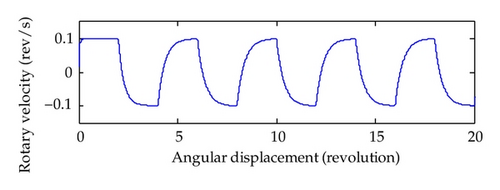
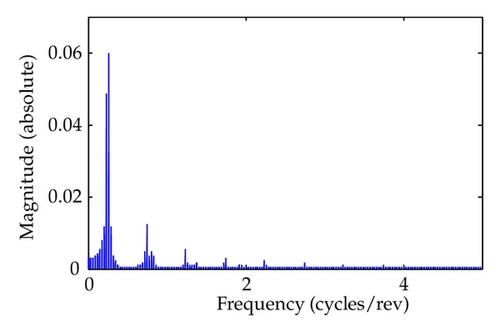
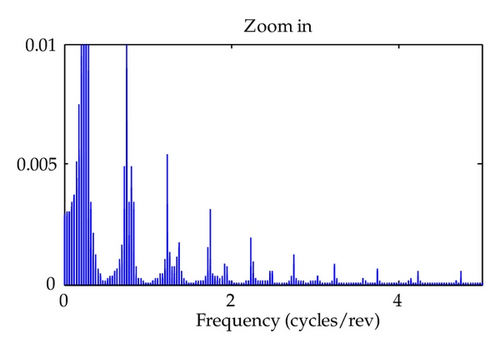
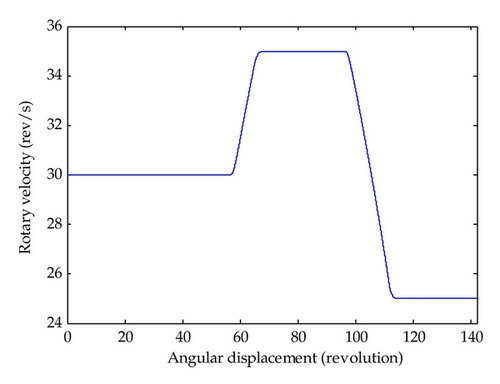
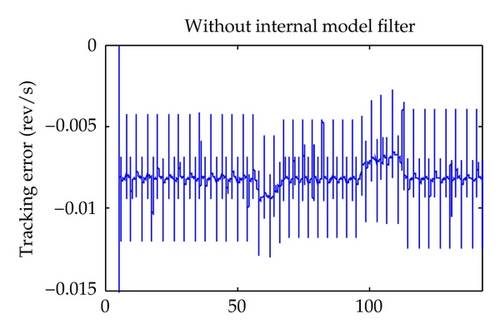
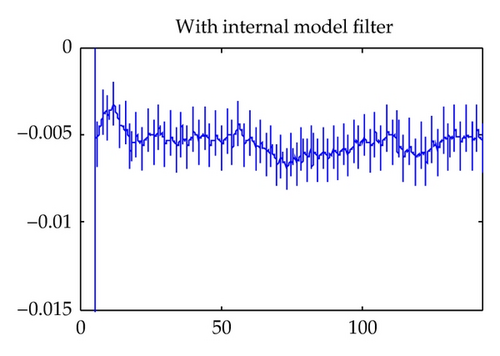
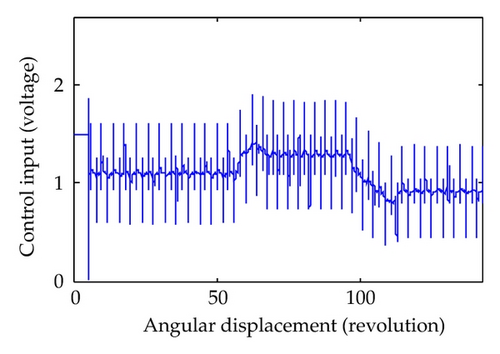
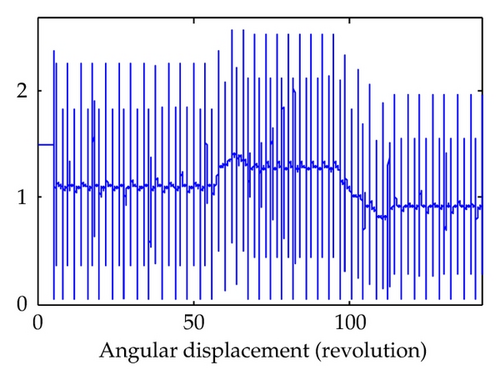
6. Conclusion
This paper presents the design of a new spatial domain adaptive control system, which can be applied to rotary systems operating at varying speeds and subject to spatially periodic and band-limited disturbances and structured/unstructured parametric uncertainties. The proposed design integrates two control paradigms, that is, adaptive backstepping and internal model control. The overall output feedback adaptive control system can be shown to be stable and have bounded state estimated error and output tracking error. Feasibility and effectiveness of the proposed design are further justified by a numerical example. Future effort will be dedicated to implementation and verification of the proposed control design to a practical rotary system, for example, a brushless dc-motor-driven control system.




